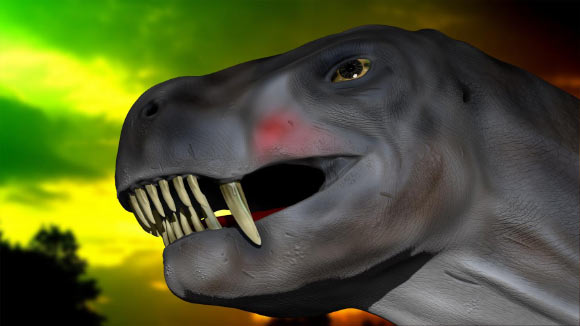When you’re a small pre-mammalian creature, sometimes the only way to protect yourself against fearsome predators like saber-toothed carnivores is to turn your saliva into a venomous cocktail. That is exactly what a therocephalian therapsid called Euchambersia mirabilis did about 257 million years ago (Permian period) in what is now South Africa.

Reconstruction of Euchambersia mirabilis; oblique ventro-lateral view showing the ridged dentition. Image credit: Alex Bernardini.
Euchambersia mirabilis was a small, dog-like creature that grew between 1.3 and 1.6 feet (40-50 cm) long, and lived well before the first dinosaur appeared.
The two known fossils of Euchambersia mirabilis were found — the first in 1932, and the second in 1966 — on the farm Vanwyksfontein, near Colesberg in South Africa, and while they were found more than 34 years apart from each other, for millions of years, they were lying only a few feet apart.
According to a new study published in the journal PLoS ONE, Euchambersia mirabilis represents the earliest known venomous terrestrial vertebrate, and one of the best supported cases of an extinct venomous species.
“What is even more surprising is that it is not in a species that we expected it to be,” said lead author Dr. Julien Benoit, a paleontologist at the University of the Witwatersrand in Johannesburg, South Africa.
“Today, snakes are notorious for their venomous bite, but their fossil record vanishes in the depth of geological times at about 167 million years ago, so, at 260 million years ago, Euchambersia mirabilis evolved venom more than a 100 million years before the very first snake was even born.”
As venom glands don’t fossilize, Dr. Benoit and co-authors used CT scanning and 3D imagery techniques to analyze the two Euchambersia skulls, and discovered stunning anatomical adaptations that are compatible with venom production.
“First, a wide, deep and circular fossa — a space in the skull — to accommodate a venom gland was present on the upper jaw and was connected to the canine and the mouth by a fine network of bony grooves and canals,” Dr. Benoit explained.
“Moreover, we discovered previously undescribed teeth hidden in the vicinity of the bones and rock: two incisors with preserved crowns and a pair of large canines, that all had a sharp ridge.”
“Such a ridged dentition would have helped the injection of venom inside a prey.”
Unlike snakes like vipers or cobras, which actively inject their prey with venom through needle-like grooves in their teeth, Euchambersia’s venom flowed directly into its mouth, and the venom was passively introduced into its victim through ridges on the outside of its canine teeth.
“Euchambersia mirabilis could have used its venom for protection or hunting,” the researchers said.
“Most venomous species today use their venom for hunting, so I would rather go for this option,” Dr. Benoit added.
“In addition, animals at that time were not all insectivorous, particularly among therapsids, which were very diverse.”
_____
J. Benoit et al. Reappraisal of the envenoming capacity of Euchambersia mirabilis (Therapsida, Therocephalia) using μCT-scanning techniques. PLoS ONE 12 (2): e0172047; doi: 10.1371/journal.pone.0172047







